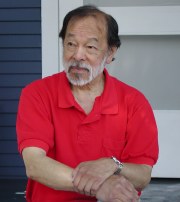Charlie Chong - 2002 | home
Viaduct 2002 - Pied Piper Music On The Viaduct | Viaduct 2001 - The Viaduct Lives! For Now?
ho'opono - "to do what's right"
Viaduct 2001 - The Viaduct Lives! For Now?
The Viaduct Lives! For Now?
by Charlie Chong
July 18, 2001
"The 2-mile viaduct, which carries more than 80,000 vehicles a day, sustained only minor damage. In fact, the [state] Transportation Department's regional bridge maintenance superintendent, Patrick Moylan, said that `maybe it is a little stronger than we thought it was.'" George Foster, Seattle P-I reporter, Friday, March 2, 2001.
"Moylan said . . . some small cracks were found . . . But no damage found was judged structurally significant, he said." Peyton Whitely, Seattle Times staff reporter, Friday, March 2, 2001.
"It [the quake] . . . closed the notoriously unstable Alaskan Way Viaduct . . ." Chris McGann, Seattle P-I reporter, Thursday, March 1, 2001.
That Alaskan Way Viaduct survived the 6.8 200l Ash Wednesday earthquake and the 6.5 1965 quake. Yet - following the earthquake, media and residents talked over and over about how vulnerable it was to collapsing. Few people know that the vulnerability of the Alaskan Way Viaduct is a myth promoted and sold by developers who want the land beneath the viaduct. Let's start with some misperceptions.
The viaduct is built on fill.
False. As described by Mac McGrath, who helped build it, the viaduct sits on pilings driven down below the fill layer, below the bottom water line, to the solid surface [referred to as hard soil by Washington state Department of Transportation/Seattle P-I, Friday, March 2, 2001]. In the north end, the pilings are all steel. In the south end, the pilings are steel to below the bottom water line and are wood below that. Should the fill layer liquefy, would the pilings snap? An earthquake construction engineer and a retired transportation employee answered no. How would we strengthen the foundation to assure doubters? Underground X braces between the four supporting columns, they answered. How deep underground? Just below the surface. How expensive? Not much.
The upper deck will collapse on the lower deck - like in Oakland.
False. The Oakland freeway design was different. The upper deck sat on top of horizontal supports and slid off. That design is similar to the South Spokane Street bridge [a separate structure from the viaduct] which, however, has "keeper" plates and blocks to keep the deck from falling off. In the Alaskan Way Viaduct, the upper and lower decks and pillars are one unit - the rebars are interconnected and the concrete was poured in what's called "one-pour."
The viaduct will collapse in a 7.5 earthquake.
Maybe. Depends on how the viaduct was built? When you drive on it, listen to the sound of your tires. You will hear the distinctive sound of what you guess are expansion joints. Actually, they are the expansion spaces between independent units or bridges. Think of the viaduct as a series of solidly one-piece coffee tables with lower shelves. In each bridge, the lower deck braces the four legs. And the cement is pure cement - with no filler added.
Why do some people want to tear down the viaduct?
Some people want it removed for aesthetic reasons. For the same reasons, some of us would like to view the Sound and Lake Washington without polluting ferry boats and floating bridges but we don't say so. Some find the viaduct noisy but are happy to add to the noise of I-5. So far, the aesthetic and noise pollution arguments have been ignored since 80,000 and more vehicles use the viaduct. As what should have been expected, the closure of the viaduct, to inspect it, produced a massive traffic jam [3 to 5 hours for what was a 20 minute trip].
The drums are beating again for an alternative, a tunnel from Spokane Street to the Battery tunnel. Nevermind that in a 7.5 earthquake - or a 9.2 - one can expect to drown like rats in the tunnel. The proposal was made earlier as a result of the state legislature passing in 1994 what was called the Public/Private Partnership Initiative. [People like me described it as where the public puts in the money and the private partners take out the profits.] The viaduct was saved by state Senator Michael Heavey, West Seattle, who succeeded in getting it too low on the list. Right now only the Tacoma Narrows Bridge remains as an approved project, approved only after the state Transportation Department gerrymandered the voting area to bury the 80% opposition of frequent users.
The proposed replacement toll tunnel would have reduced traffic lanes from six to only four, two each way, despite morning commute backups now. Who would have benefited? The bond lawyers, the bankers, the builders and, yes, the developers who expected to get the land under the viaduct. For parks, they said. For office and condo buildings, we said - a gold coast worth a billion dollars. The Port of Seattle would have gotten the land over a cut-and-cover tunnel from the viaduct south to Spokane Street, allowing an expansion of their freight yards over the covered Alaskan Way.
Who do we watch?
First, the state Department of Transportation. It has a $500,000 contract with the Mirai engineering firm to study alternatives. Study due in the fall of 2002 or earlier. The state Transportation Commission would decide on alternatives which could include an "underground structure." An alternative could be retrofitting but already they're saying a retrofit would cost more than building a new structure. Bet on a toll tunnel. Also, watch the Puget Sound Regional Council for pushing federal funding [the former PSCOG, same players that gave us the proposed environmental disaster, Sea-Tac's Third Runway]. More than anything, watch your local, beloved state legislators, not what they say at home but do down in Olympia. Watch your city council do nothing.
###

